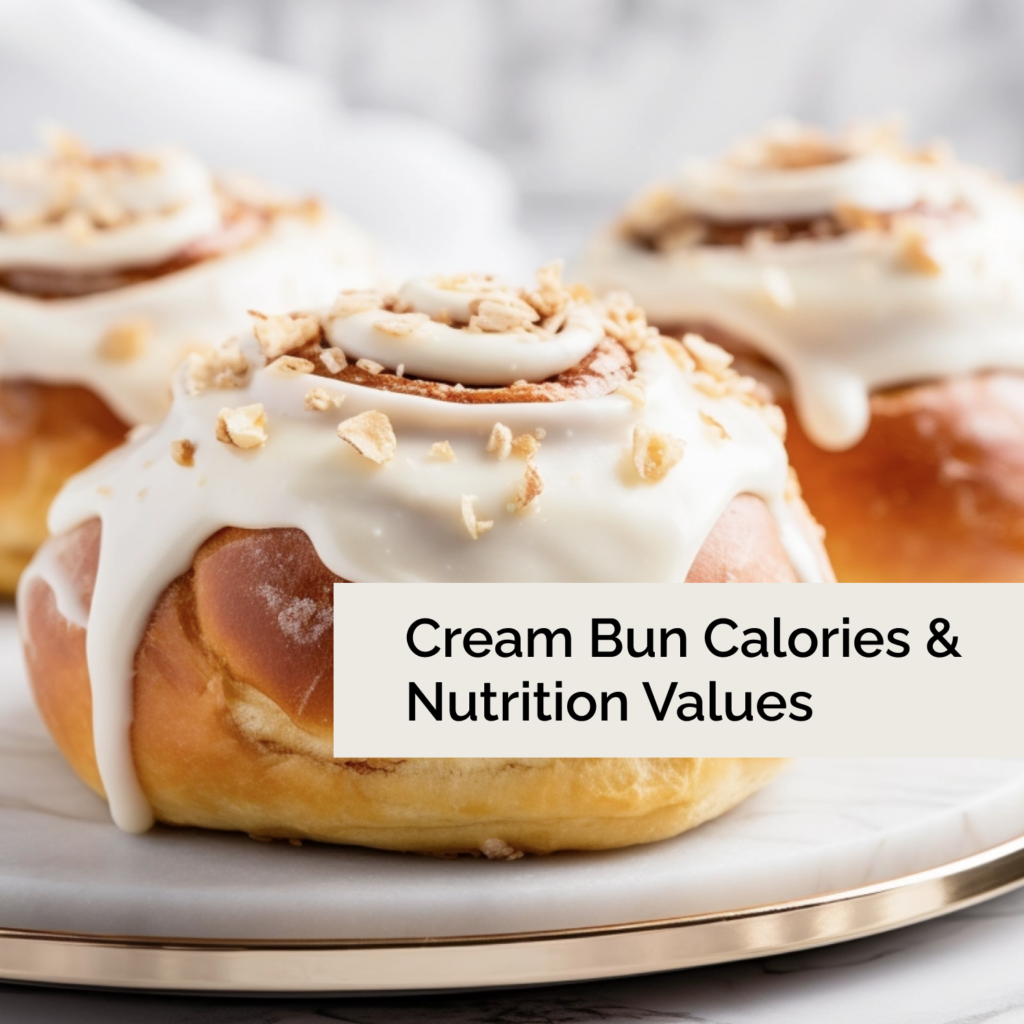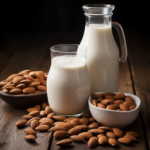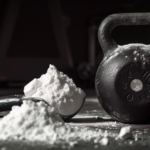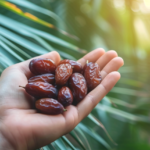A Cream Bun (101 g) has 265 Calories. It also contain –
- Calories: 265
- Fat: 9.6g (mostly saturated: 5.6g)
- Cholesterol: 59mg
- Sodium: 441mg
- Carbs: 37.7g
- Protein: 6.7g
- Caffeine: 0mg
Cream buns, those fluffy clouds filled with creamy goodness, are a delightful treat. But just like any delicious thing, it’s helpful to know what’s hiding inside, especially when it comes to calories. Just like counting steps helps you stay active, understanding cream bun calories helps you make informed choices about enjoying them without feeling guilty later.
In this blog, we’ll delve into the role of moderation and balance in a healthy diet, shedding light on how we can savour cream buns responsibly while prioritising our overall health. Additionally, we’ll uncover alternatives and healthier variations for those seeking lower-calorie options, ensuring that everyone can indulge in the joy of cream buns without guilt or compromise.
Cream Bun Calories
Cream bun’s fluffy exterior and creamy heart are a siren song for many, but lurking beneath that deliciousness lies a secret: calories. Fear not, treat lovers! This section will dissect the calorie in cream buns, empowering you to indulge mindfully.
Dissecting the Bun vs. the Filling:
Imagine a cream bun as a calorie puzzle. Each piece contributes to the overall total, so let’s break it down:
| Component | Calorie Range | Comparison |
|---|---|---|
| Bun (plain, medium size) | 100-200 | Similar to a small croissant (130 calories) |
| Custard Filling | 150-200 | Equivalent to a small apple (95 calories) |
| Whipped Cream Filling | 100-150 | Roughly equal to a banana (105 calories) |
| Chocolate Topping | 50-100 | Comparable to a handful of M&Ms (50 calories) |
Size Matters: Portion Control is Key
Just like clothes, cream buns come in all sizes, and larger sizes pack a bigger calorie punch. Consider this:
| Size | Approximate Calorie Count |
|---|---|
| Mini Cream Bun | 150-200 |
| Standard Cream Bun | 200-250 |
| Jumbo Cream Bun | 350-400 |
Portion control is crucial for enjoying cream buns guilt-free. Instead of grabbing the biggest one, opt for a mini version or share a standard one with a friend. Savor each bite and truly appreciate the flavors, making the experience more satisfying with fewer calories.
Remember, knowledge is power! By understanding the calorie breakdown of cream buns and practicing mindful eating, you can enjoy these delightful treats without sacrificing your health goals.
Cream Bun Nutrition Value
Overview of the nutritional content of different types of cream buns, helping you compare and make informed choices. Remember, values can vary based on specific ingredients and brands.
| Cream Bun Type | Fat (g) | Saturated Fat (g) | Carbohydrates (g) | Sugar (g) | Protein (g) | Fiber (g) |
|---|---|---|---|---|---|---|
| Small, Plain | 8-12 | 4-6 | 30-40 | 15-20 | 2-3 | 1-2 |
| Medium-Sized, Plain | 10-15 | 5-7 | 40-50 | 20-25 | 3-4 | 1-3 |
| Large, Plain | 12-18 | 6-8 | 50-60 | 25-30 | 4-5 | 2-4 |
| Chocolate Flavored | 14-20 | 7-9 | 45-55 | 25-35 | 3-4 | 1-3 |
| Custard Flavored | 15-22 | 8-10 | 40-50 | 20-30 | 3-4 | 1-2 |
| Glazed | +3-6 | +2-4 | +5-10 | +5-10 | 0 |
Important Notes:
- These are estimated values and can vary depending on recipe, ingredients, and brand.
- Fat content primarily comes from saturated fat, which should be consumed in moderation.
- Sugar content is high, especially in glazed and flavored cream buns.
- Protein and fiber content are low compared to carbohydrates and sugar.
- This table offers a general comparison and is not a substitute for professional dietary advice.
Read Also – Calories in Balushahi
Impact of Cream Buns on Health and Wellness
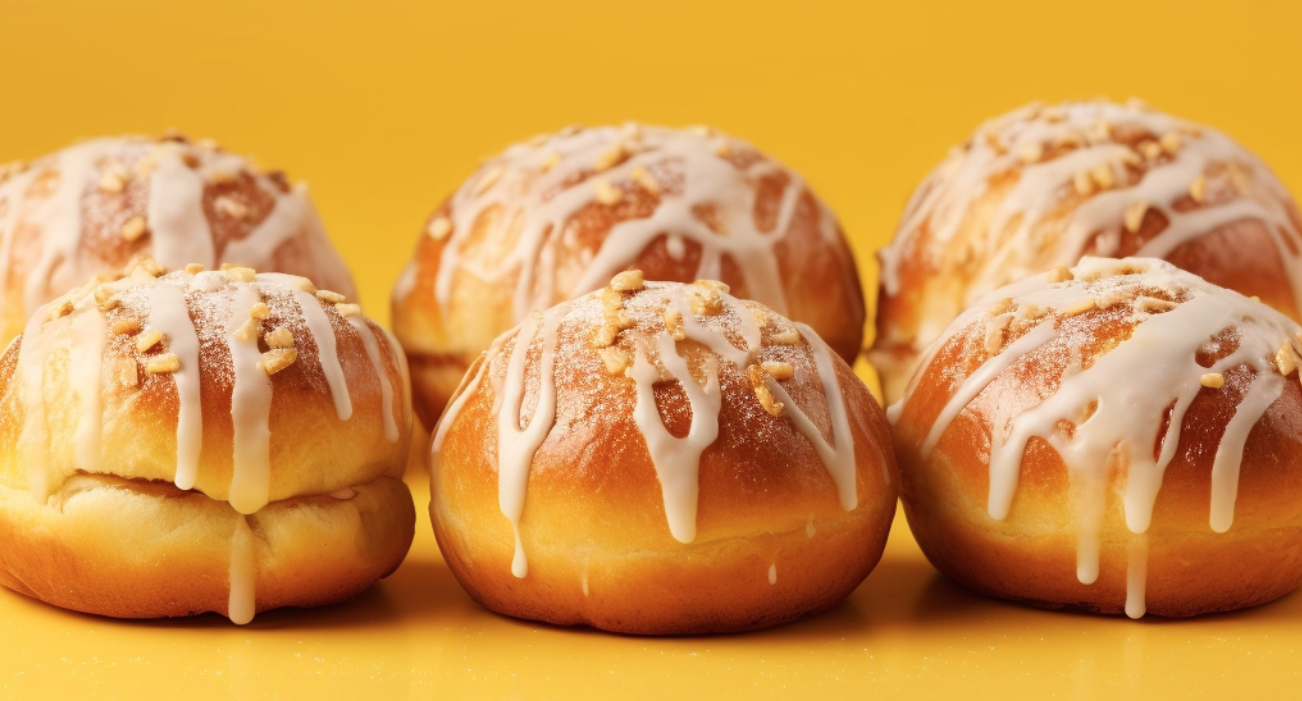
Cream buns, with their delectable combination of soft dough and rich cream filling, undoubtedly offer a delightful sensory experience. However, their impact on health and wellness extends beyond mere enjoyment, encompassing both positive and negative aspects. Let’s delve into the multifaceted effects of cream buns on our well-being.
Positive Aspects:
- Enjoyment and Satisfaction: Cream buns can provide a sense of pleasure and satisfaction, contributing to overall well-being by fulfilling cravings and boosting mood. Indulging in occasional treats can enhance the quality of life and foster a healthy relationship with food.
- Energy Source: Cream buns contain carbohydrates from flour and sugars, providing a quick source of energy. For individuals engaged in physical activities or needing an energy boost, consuming a cream bun in moderation can be beneficial.
Negative Aspects:
- Caloric Density: Cream buns are calorie-dense due to their high fat and sugar content. Excessive consumption can lead to weight gain and contribute to obesity, a risk factor for various health conditions such as diabetes, heart disease, and certain cancers.
- Saturated Fats: The cream filling in cream buns often contains saturated fats, which can increase levels of LDL cholesterol and raise the risk of cardiovascular diseases when consumed in excess.
- Added Sugars: The sugar content in cream buns contributes to their sweetness but can also lead to spikes in blood sugar levels. Over time, excessive sugar intake may contribute to insulin resistance, metabolic syndrome, and type 2 diabetes.
- Nutrient Imbalance: Cream buns are low in essential nutrients such as vitamins, minerals, and fiber. Regular consumption without balancing with nutrient-rich foods can lead to nutrient imbalances and deficiencies.
- Digestive Discomfort: The combination of refined flour and high-fat cream filling may cause digestive discomfort in some individuals, such as bloating, gas, or indigestion.
Moderation and Balance:
The key to incorporating cream buns into a healthy lifestyle lies in moderation and balance. Enjoying them occasionally as part of a well-rounded diet can offer pleasure without compromising overall health. Here are some strategies to consider:
- Portion Control: Opt for smaller-sized cream buns or share larger ones with others to manage calorie intake.
- Mindful Eating: Pay attention to hunger cues and savor each bite of a cream bun mindfully, focusing on taste, texture, and satisfaction.
- Balanced Diet: Pair cream buns with nutrient-rich foods such as fruits, vegetables, lean proteins, and whole grains to create balanced meals.
- Homemade Options: Experiment with homemade cream bun recipes using healthier ingredients such as whole-grain flour, reduced-fat cream, and natural sweeteners to control the nutritional content.
- Physical Activity: Incorporate regular physical activity into your routine to help offset the calories consumed from cream buns and promote overall health and fitness.
Wrapping Up
So, the cream bun: friend or foe on your health journey? The answer, dear reader, lies not in strict bans or guilt-ridden indulgences, but in informed choices and mindful enjoyment. We’ve delved into the world of cream bun calories, dissecting their components and exploring lighter options. Remember, knowledge empowers you! Reading labels, practicing portion control, and even baking with healthier ingredients are all tools in your toolbox.
But don’t forget the other half of the equation: mindful enjoyment. Savor each bite, pair your treat with healthier choices, and incorporate physical activity for a balanced approach. Ultimately, a healthy lifestyle isn’t about eliminating treats, but about enjoying them consciously and making informed decisions that fit your goals. So go forth, armed with knowledge and empowered to relish that occasional cream bun without letting the guilt steal your sweetness! Remember, a balanced life is a happy life, and a treat now and then can be part of that beautiful journey.
References –
https://www.fatsecret.com.au/calories-nutrition/homestyle-bake/cream-bun/1-bun
Read Also – Benefits of Coconut Oil Massage on Face
How much calories does 1 cream bun contain?
A cream bun typically contains around 250-300 calories, but this can vary depending on the size and ingredients used.
How many calories in a mock cream bun?
A mock cream bun, which may use substitutes for traditional cream, could have a similar calorie content to a regular cream bun, again around 250-300 calories.
Is bun high in calories?
Whether a bun is considered high in calories depends on your dietary goals and overall calorie intake. Compared to some other foods, a cream bun might be considered high in calories for its portion size.
How many calories are in an Indian cream roll?
An Indian cream roll can vary in calorie content depending on its size and ingredients, but it’s typically around 200-300 calories per roll.
How many calories are in a Maida bun?
A Maida bun, made with refined wheat flour, can have a similar calorie content to a regular bun, around 250-300 calories.
How many calories should I eat to lose weight?
The number of calories you should eat to lose weight depends on various factors such as your age, gender, weight, height, activity level, and weight loss goals. Generally, creating a calorie deficit of 500-1000 calories per day can lead to a safe and sustainable weight loss of about 1-2 pounds per week. However, it’s advisable to consult with a healthcare professional or a registered dietitian to determine the appropriate calorie intake for your specific needs and goals.

